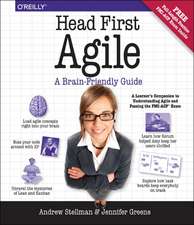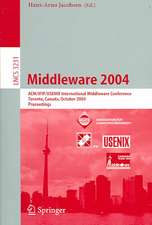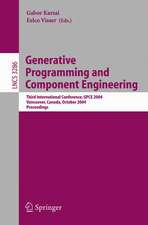Reverse Engineering of Object Oriented Code: Monographs in Computer Science
Autor Paolo Tonella, Alessandra Potrichen Limba Engleză Hardback – 17 dec 2004
| Toate formatele și edițiile | Preț | Express |
|---|---|---|
| Paperback (1) | 641.99 lei 6-8 săpt. | |
| Springer – 26 mai 2011 | 641.99 lei 6-8 săpt. | |
| Hardback (1) | 647.61 lei 6-8 săpt. | |
| Springer – 17 dec 2004 | 647.61 lei 6-8 săpt. |
Din seria Monographs in Computer Science
- 20%
 Preț: 1322.33 lei
Preț: 1322.33 lei - 20%
 Preț: 511.92 lei
Preț: 511.92 lei - 20%
 Preț: 1285.31 lei
Preț: 1285.31 lei - 20%
 Preț: 333.22 lei
Preț: 333.22 lei - 20%
 Preț: 328.60 lei
Preț: 328.60 lei - 15%
 Preț: 646.94 lei
Preț: 646.94 lei - 20%
 Preț: 357.48 lei
Preț: 357.48 lei - 20%
 Preț: 339.47 lei
Preț: 339.47 lei - 20%
 Preț: 653.21 lei
Preț: 653.21 lei - 20%
 Preț: 329.44 lei
Preț: 329.44 lei - 20%
 Preț: 993.74 lei
Preț: 993.74 lei - 20%
 Preț: 992.26 lei
Preț: 992.26 lei - 20%
 Preț: 1630.95 lei
Preț: 1630.95 lei - 20%
 Preț: 656.03 lei
Preț: 656.03 lei - 20%
 Preț: 650.08 lei
Preț: 650.08 lei - 20%
 Preț: 328.09 lei
Preț: 328.09 lei - 20%
 Preț: 641.16 lei
Preț: 641.16 lei - 20%
 Preț: 334.38 lei
Preț: 334.38 lei - 18%
 Preț: 737.74 lei
Preț: 737.74 lei - 20%
 Preț: 642.19 lei
Preț: 642.19 lei - 20%
 Preț: 641.99 lei
Preț: 641.99 lei - 20%
 Preț: 345.59 lei
Preț: 345.59 lei - 20%
 Preț: 711.29 lei
Preț: 711.29 lei - 20%
 Preț: 1001.16 lei
Preț: 1001.16 lei - 20%
 Preț: 661.47 lei
Preț: 661.47 lei - 20%
 Preț: 343.62 lei
Preț: 343.62 lei - 20%
 Preț: 644.81 lei
Preț: 644.81 lei - 15%
 Preț: 505.30 lei
Preț: 505.30 lei - 20%
 Preț: 640.69 lei
Preț: 640.69 lei -
 Preț: 396.78 lei
Preț: 396.78 lei - 18%
 Preț: 956.81 lei
Preț: 956.81 lei - 20%
 Preț: 592.68 lei
Preț: 592.68 lei - 20%
 Preț: 329.44 lei
Preț: 329.44 lei -
 Preț: 383.33 lei
Preț: 383.33 lei - 20%
 Preț: 349.40 lei
Preț: 349.40 lei - 20%
 Preț: 832.40 lei
Preț: 832.40 lei - 20%
 Preț: 993.42 lei
Preț: 993.42 lei - 15%
 Preț: 578.87 lei
Preț: 578.87 lei - 20%
 Preț: 337.85 lei
Preț: 337.85 lei - 20%
 Preț: 988.16 lei
Preț: 988.16 lei - 20%
 Preț: 996.56 lei
Preț: 996.56 lei - 20%
 Preț: 1293.37 lei
Preț: 1293.37 lei - 20%
 Preț: 1452.94 lei
Preț: 1452.94 lei
Preț: 647.61 lei
Preț vechi: 809.51 lei
-20% Nou
Puncte Express: 971
Preț estimativ în valută:
123.92€ • 132.51$ • 103.32£
123.92€ • 132.51$ • 103.32£
Carte tipărită la comandă
Livrare economică 17 aprilie-01 mai
Preluare comenzi: 021 569.72.76
Specificații
ISBN-13: 9780387402956
ISBN-10: 0387402950
Pagini: 208
Ilustrații: XIV, 208 p. 80 illus.
Dimensiuni: 155 x 235 x 18 mm
Greutate: 0.48 kg
Ediția:2005
Editura: Springer
Colecția Springer
Seria Monographs in Computer Science
Locul publicării:New York, NY, United States
ISBN-10: 0387402950
Pagini: 208
Ilustrații: XIV, 208 p. 80 illus.
Dimensiuni: 155 x 235 x 18 mm
Greutate: 0.48 kg
Ediția:2005
Editura: Springer
Colecția Springer
Seria Monographs in Computer Science
Locul publicării:New York, NY, United States
Public țintă
ResearchCuprins
The Object Flow Graph.- Class Diagram.- Object Diagram.- Interaction Diagrams.- State Diagrams.- Package Diagram.- Conclusions.
Recenzii
From the reviews of the first edition:
"The monograph at hand is a well-written, well-structured guide for reverse engineering of complex object-oriented programs i.e., for extracting original design specifications as far as possible in a form easily understandable by a re-designer team. … 100 + literature references at the end of the book demonstrate the deep research and strong know-how of the authors and make the book a valuable monographic textbook for reverse engineering courses of object-oriented programs." (Hans-Jürgen Hoffmann, Zentralblatt MATH, Vol. 1070, 2005)
"The monograph at hand is a well-written, well-structured guide for reverse engineering of complex object-oriented programs i.e., for extracting original design specifications as far as possible in a form easily understandable by a re-designer team. … 100 + literature references at the end of the book demonstrate the deep research and strong know-how of the authors and make the book a valuable monographic textbook for reverse engineering courses of object-oriented programs." (Hans-Jürgen Hoffmann, Zentralblatt MATH, Vol. 1070, 2005)
Textul de pe ultima copertă
In software evolution and maintenance, the ultimate, most reliable description of a system is its source code. Reverse engineering aims at extracting abstract, goal-oriented views from the code, to summarize relevant properties of program computations.
Reverse Engineering of Object Oriented Code presents a unifying framework for the analysis of object oriented code. Using Unified Modeling Language (UML) to represent the extracted design diagrams, the book explains how to recover them from object oriented code, thereby enabling developers to better comprehend their product and evaluate the impact of changes to it. Furthermore, it describes the algorithms involved in recovering views and demonstrates some of the techniques that can be employed for their visualization. The presentation is fully self-contained.
Topics and Features:
*Provides unique, in-depth exposition of the core concepts, principles, and methods behind reverse engineering object oriented code
*Explains the techniques and algorithms through numerous examples of object oriented code, the leading programming paradigm
*Focuses on fully automated design recovery, and deals with static and dynamic source-code analysis algorithms
*Explores code-centered analysis to obtain design diagrams aligned with the implementation
*Describes structural and behavioral views to offer a multi-perspective assessment of the system being analyzed
*Reports the analysis results in UML, the standard language for representing design diagrams in object oriented program development
This new state-of-the-art volume covers core methodologies for reverse engineering object oriented code, allowing for improved control in future code maintenance and modification. It is a significant resource for researchers and software engineers in the areas of reverse engineering, code analysis, object oriented programming, and UML. In addition, it will be invaluable as the reference book for advanced courses in these areas.
Reverse Engineering of Object Oriented Code presents a unifying framework for the analysis of object oriented code. Using Unified Modeling Language (UML) to represent the extracted design diagrams, the book explains how to recover them from object oriented code, thereby enabling developers to better comprehend their product and evaluate the impact of changes to it. Furthermore, it describes the algorithms involved in recovering views and demonstrates some of the techniques that can be employed for their visualization. The presentation is fully self-contained.
Topics and Features:
*Provides unique, in-depth exposition of the core concepts, principles, and methods behind reverse engineering object oriented code
*Explains the techniques and algorithms through numerous examples of object oriented code, the leading programming paradigm
*Focuses on fully automated design recovery, and deals with static and dynamic source-code analysis algorithms
*Explores code-centered analysis to obtain design diagrams aligned with the implementation
*Describes structural and behavioral views to offer a multi-perspective assessment of the system being analyzed
*Reports the analysis results in UML, the standard language for representing design diagrams in object oriented program development
This new state-of-the-art volume covers core methodologies for reverse engineering object oriented code, allowing for improved control in future code maintenance and modification. It is a significant resource for researchers and software engineers in the areas of reverse engineering, code analysis, object oriented programming, and UML. In addition, it will be invaluable as the reference book for advanced courses in these areas.
Caracteristici
This unique volume not only provides a comprehensive presentation of how to design object-oriented program code, but more specifically also focuses on the reverse engineering of Object Oriented design diagrams. It is the only known volume to do so. The accompanying algorithms, which can be reversed engineered, allow for greater flexibility in future code maintenance and modification




















